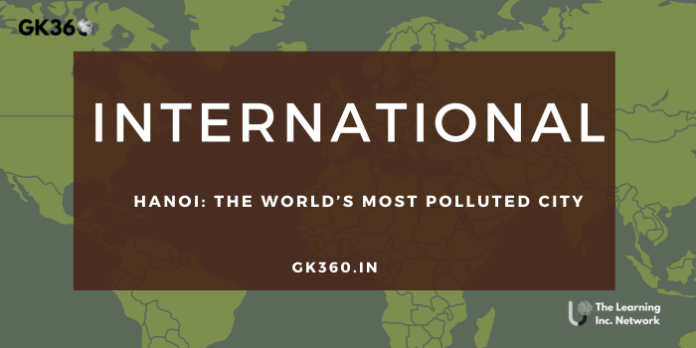Hanoi Air Pollution Crisis 2025: The World’s Most Polluted City
Introduction
Hanoi, the capital of Vietnam, has made headlines for an alarming reason—it has been declared the world’s most polluted city in 2025, with PM2.5 levels soaring to 266 micrograms per cubic meter. This unprecedented deterioration in air quality has raised serious health concerns, prompting government intervention and public outcry. But what is behind this crisis, and what steps are being taken to combat it?

Table of Contents
- Hanoi’s Air Pollution Crisis – Breaking Records in 2025
- What is Causing Hanoi’s Severe Air Pollution?
- Health Impact: How Hanoi’s Air Pollution is Affecting Residents
- Government Response: What Measures Are Being Taken?
- Expert Opinions: Can Hanoi Solve its Air Pollution Problem?
- FAQs
- Conclusion & Call to Action
Hanoi’s Air Pollution Crisis – Breaking Records in 2025
On January 3, 2025, AirVisual, a leading global air quality monitoring platform, reported that Hanoi recorded the highest PM2.5 levels in the world. The concentration of 266 micrograms per cubic meter signifies an environmental emergency, far exceeding the World Health Organization’s (WHO) safe limit of 25 micrograms per cubic meter.
What is Causing Hanoi’s Severe Air Pollution?
Heavy Traffic & Vehicle Emissions
Hanoi’s streets are densely packed with vehicles, many of which use outdated, high-emission engines. Traffic congestion leads to prolonged exposure to harmful pollutants, worsening the city’s already toxic air.
Industrial Emissions
Factories and manufacturing plants located within and around the city release toxic gases and particulate matter into the atmosphere. These emissions add to the already hazardous pollution levels.
Open Waste Burning
A major issue contributing to Hanoi’s pollution is the practice of burning trash in open spaces. This releases dangerous chemicals such as dioxins and fine particulate matter, which are known to cause severe respiratory issues.
Weather Conditions: The Pollution Trap
Hanoi’s geographical position and seasonal weather patterns play a significant role in trapping pollutants. Low temperatures and weak winds prevent air circulation, allowing smog to linger over the city for extended periods.
Health Impact: How Hanoi’s Air Pollution is Affecting Residents
Respiratory Diseases & Long-Term Health Risks
Pollution exposure is linked to an increase in asthma, chronic obstructive pulmonary disease (COPD), and bronchitis. Hanoi’s elderly population is particularly vulnerable to these health complications.
Impact on Children & Elderly
Children are experiencing reduced lung function and developmental issues due to prolonged exposure to toxic air. Many residents also report eye irritation, fatigue, and headaches as immediate effects of the pollution.
Government Response: What Measures Are Being Taken?
Electric Vehicle Adoption Plans
Vietnamese authorities have announced ambitious targets for electric vehicle (EV) adoption. By 2030, Hanoi aims for 50% of buses and 100% of taxis to be electric.
Anti-Pollution Regulations & Industry Monitoring
Stricter industrial regulations and fines for excessive emissions are being enforced to hold businesses accountable for their environmental impact.
Public Awareness Campaigns
The government is launching education initiatives to encourage waste reduction, tree planting, and responsible industrial practices to combat pollution.
Expert Opinions: Can Hanoi Solve its Air Pollution Problem?
Environmental expert Huy Nguyen warns that Hanoi’s pollution problem is deeply rooted in both human activities and unfavorable weather conditions. While transitioning to electric vehicles is a positive step, experts stress the need for waste management reforms, improved industrial policies, and investment in public transport to see long-term improvements.
FAQs
- What are the main causes of Hanoi’s air pollution?The primary causes include vehicle emissions, industrial pollution, open waste burning, and stagnant weather conditions.
- How dangerous is Hanoi’s PM2.5 level?Hanoi’s PM2.5 level of 266 micrograms per cubic meter is ten times higher than the WHO’s safe limit, making it extremely hazardous to public health.
- What actions is the government taking?The government is promoting electric vehicles, imposing stricter industrial regulations, and launching public awareness campaigns.
- How can residents protect themselves from pollution?Residents are advised to wear N95 masks, use air purifiers indoors, and limit outdoor activities during high pollution periods.
- What cities have worse air pollution than Hanoi?Currently, Hanoi ranks as the world’s most polluted city, surpassing Delhi, Beijing, and Lahore.
Conclusion & Call to Action
Hanoi’s worsening air pollution crisis is a stark reminder of the urgent need for action. While government initiatives, such as EV promotion and stricter regulations, are promising, a multi-faceted approach addressing industrial emissions, waste management, and public awareness is necessary.
Key Takeaways
| Key Factor | Details |
|---|---|
| Most Polluted City | Hanoi recorded PM2.5 levels of 266 µg/m³, surpassing global pollution hotspots. |
| Health Emergency | Pollution causes respiratory diseases, eye irritation, and long-term health issues. |
| Major Pollution Sources | Vehicle emissions, industrial pollution, and open waste burning worsen air quality. |
| Weather Trap | Cold temperatures and weak winds prevent pollutants from dispersing. |
| Government Action | Policies include electric vehicle adoption, stricter regulations, and public awareness campaigns. |
Related Terms:
- Hanoi Air Pollution 2025
- World’s Most Polluted City
- PM2.5 Levels in Hanoi
- Health Effects of Air Pollution
- Vietnam Pollution Crisis
- Causes of Air Pollution in Hanoi
- Government Action on Pollution
- Hanoi Air Quality 2025
- Electric Vehicles in Vietnam
- How to Protect Against Air Pollution






